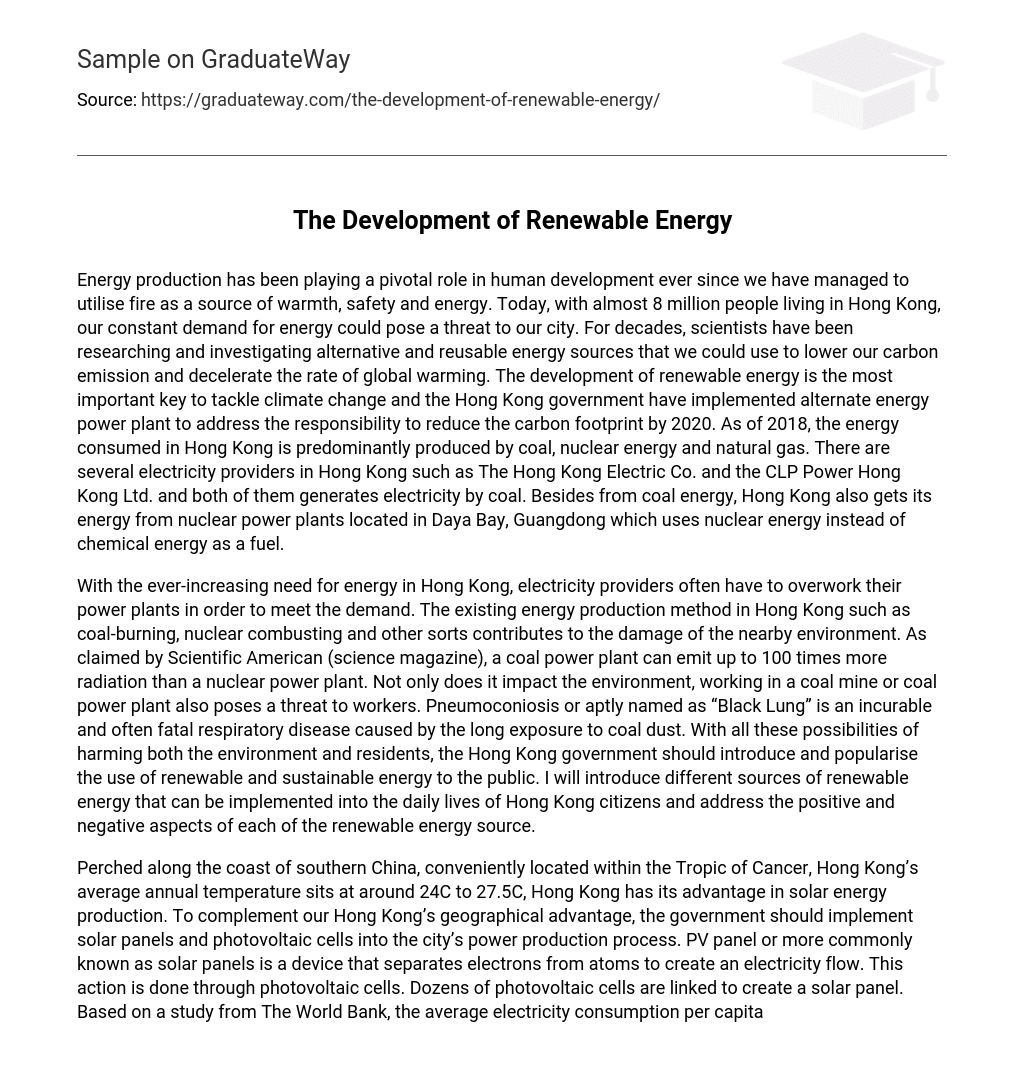Energy production has been playing a pivotal role in human development ever since we have managed to utilise fire as a source of warmth, safety and energy. Today, with almost 8 million people living in Hong Kong, our constant demand for energy could pose a threat to our city. For decades, scientists have been researching and investigating alternative and reusable energy sources that we could use to lower our carbon emission and decelerate the rate of global warming. The development of renewable energy is the most important key to tackle climate change and the Hong Kong government have implemented alternate energy power plant to address the responsibility to reduce the carbon footprint by 2020. As of 2018, the energy consumed in Hong Kong is predominantly produced by coal, nuclear energy and natural gas. There are several electricity providers in Hong Kong such as The Hong Kong Electric Co. and the CLP Power Hong Kong Ltd. and both of them generates electricity by coal. Besides from coal energy, Hong Kong also gets its energy from nuclear power plants located in Daya Bay, Guangdong which uses nuclear energy instead of chemical energy as a fuel.
With the ever-increasing need for energy in Hong Kong, electricity providers often have to overwork their power plants in order to meet the demand. The existing energy production method in Hong Kong such as coal-burning, nuclear combusting and other sorts contributes to the damage of the nearby environment. As claimed by Scientific American (science magazine), a coal power plant can emit up to 100 times more radiation than a nuclear power plant. Not only does it impact the environment, working in a coal mine or coal power plant also poses a threat to workers. Pneumoconiosis or aptly named as “Black Lung” is an incurable and often fatal respiratory disease caused by the long exposure to coal dust. With all these possibilities of harming both the environment and residents, the Hong Kong government should introduce and popularise the use of renewable and sustainable energy to the public. I will introduce different sources of renewable energy that can be implemented into the daily lives of Hong Kong citizens and address the positive and negative aspects of each of the renewable energy source.
Perched along the coast of southern China, conveniently located within the Tropic of Cancer, Hong Kong’s average annual temperature sits at around 24C to 27.5C, Hong Kong has its advantage in solar energy production. To complement our Hong Kong’s geographical advantage, the government should implement solar panels and photovoltaic cells into the city’s power production process. PV panel or more commonly known as solar panels is a device that separates electrons from atoms to create an electricity flow. This action is done through photovoltaic cells. Dozens of photovoltaic cells are linked to create a solar panel. Based on a study from The World Bank, the average electricity consumption per capita of Hong Kong as of 2014 is 6083.27 kWh. To illustrate, Hong Kong gets around 4 hours of sun every day and if that gets multiplied by 250 watts, energy output. That would be 1000 watts every day and we can expect one single solar panel to generate up to 30000 watts every month. In that sense, it takes around 202 months for a single solar panel to cover that amount of electricity. Thankfully, watts emitted from solar panels multiplies quickly meaning that solar panels will significantly reduce our carbon footprint without ease. In this sense, there are enough reasons to believe that solar panel is one of the sensible ways to supply Hong Kong with more sustainable and renewable energy.
As modern as technology can possibly be at the moment, only biofuel cars have gone into the mainstream in the recent decade. Biofuel boats and biofuel trains are yet to be introduced. However, as recently as January 2019, an Emirati airline company, Etihad Airways, has flown their first-ever commercial flight from Abu Dhabi to Amsterdam powered by homegrown biofuels derived from plants grown in the desert sand at Masdar Campus, Khalifa University. In order to produce homegrown biofuel, the seawater energy and agricultural system pumps seawater inland, creating a farm where they grow fish or shrimps. Whilst the marine animals continue to grow, the company use their waste as a liquid fertiliser to irrigate fields of biofuel crops and extract oil from the crops, producing aforesaid, biofuel. By using sustainable feedstock, the production of biofuel significantly reduces the life-cycle of carbon dioxide; some studies prove that biofuel reduces greenhouse gases by up to 65%. Despite the fact that the market is shifting towards electrifying road vehicles like cars, trucks and trains, the utilisation of biofuel is still a valid option generating power for huge, pollution-heavy vehicles such as aeroplanes and container ships. Whereas crude oil is a finite resource that comes from the compression of dead living organisms from millions of years ago, biofuels can be produced from a wide range of materials particularly maize, corn, sugarcane and manure. This denotes that biofuels can be produced locally, which is another reason why biofuels are more affordable compared to fossil fuels. It is undeniable that biofuels are expensive to make even with all the pros linked with biofuels.





